Alethinophidia
_female_from_Anjouan_(ZSM_40-2010).png.webp)
Lycodryas maculatus
Les Alethinophidia sont un infra-ordre de serpents.
Classification
Ils regroupe toutes les familles de serpents autres que les serpents aveugles qui forment l'infra-ordre des scolécophidiens.
Liste des familles actuelles
Selon The Reptile Database ():
- Aniliidae Stejneger, 1907
- Bolyeriidae Hoffstetter, 1946
- Tropidophiidae Brongersma, 1951
- Xenophidiidae Wallach & Günther, 1998
- Super-famille Acrochordoidea:
- Acrochordidae Bonaparte, 1831
- Super-famille Booidea:
- Boidae Gray, 1825
- Super-famille Colubroidea:
- Colubridae Oppel, 1811
- Dipsadidae Bonaparte, 1838
- Elapidae Boie, 1827
- Homalopsidae Bonaparte, 1845
- Lamprophiidae Fitzinger, 1843
- Natricidae Bonaparte, 1838
- Pareidae Romer, 1956
- Pseudoxenodontidae McDowell, 1987
- Viperidae Oppel, 1811
- Xenodermidae Gray, 1849
- Super-famille Pythonoidea:
- Loxocemidae Cope, 1861
- Pythonidae Fitzinger, 1826
- Xenopeltidae Bonaparte, 1845
- Super-famille Uropeltoidea:
- Anomochilidae Cundall, Wallach & Rossman, 1993
- Cylindrophiidae Fitzinger, 1843
- Uropeltidae Müller, 1832
_(8691264281).jpg.webp) Acrochordus arafurae, un Acrochordidae
Acrochordus arafurae, un Acrochordidae_(14112604251).jpg.webp) Anilius scytale, un Aniliidae
Anilius scytale, un Aniliidae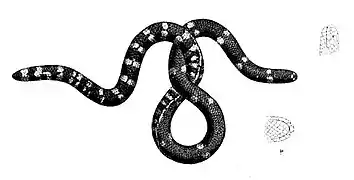 Anomochilus weberi, un Anomochilidae
Anomochilus weberi, un Anomochilidae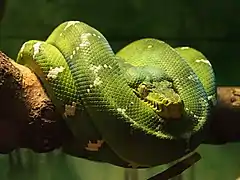 Corallus caninus, un Boidae
Corallus caninus, un Boidae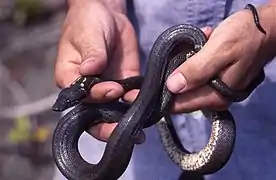 Casarea dussumieri, un Bolyeriidae
Casarea dussumieri, un Bolyeriidae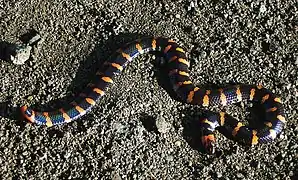 Cylindrophis ruffus, un Cylindrophiidae
Cylindrophis ruffus, un Cylindrophiidae Siphlophis compressus, un Dipsadidae
Siphlophis compressus, un Dipsadidae
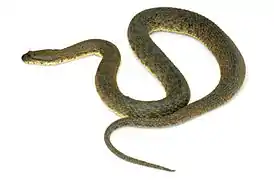 Cerberus schneiderii, un Homalopsidae
Cerberus schneiderii, un Homalopsidae%252C_Nig%C3%BCella%252C_Zaragoza%252C_Espa%C3%B1a%252C_2017-05-24%252C_DD_07.jpg.webp) Malpolon monspessulanus, un Lamprophiidae
Malpolon monspessulanus, un Lamprophiidae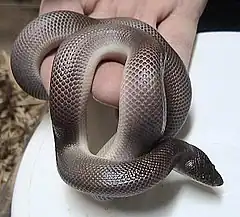 Loxocemus bicolor, un Loxocemidae
Loxocemus bicolor, un Loxocemidae--Ringelnatter.jpg.webp) Natrix natrix, un Natricidae
Natrix natrix, un Natricidae.jpg.webp) Pareas margaritophorus, un Pareatidae
Pareas margaritophorus, un Pareatidae.jpg.webp) Pseudoxenodon macrops, un Pseudoxenodontidae
Pseudoxenodon macrops, un Pseudoxenodontidae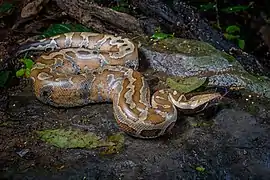 Python brongersmai, un Pythonidae
Python brongersmai, un Pythonidae_(8577519434).jpg.webp) Tropidophis melanurus, un Tropidophiidae
Tropidophis melanurus, un Tropidophiidae.jpg.webp) Melanophidium khairei, un Uropeltidae
Melanophidium khairei, un Uropeltidae.jpg.webp) Bothriechis schlegelii, un Viperidae
Bothriechis schlegelii, un Viperidae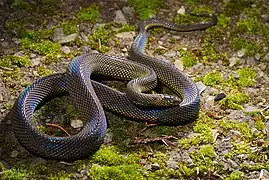 Achalinus formosanus, un Xenodermatidae
Achalinus formosanus, un Xenodermatidae_(7121228691).jpg.webp) Xenopeltis unicolor, un Xenopeltidae
Xenopeltis unicolor, un Xenopeltidae
Phylogénie
Phylogénie des familles actuelles de serpents, d'après Wiens et al., 2012[1] et Zeng et Wiens, 2016[2] :
| Serpentes |
| ||||||||||||||||||||||||||||||||||||||||||||||||||||||||||||||||||||||||||||||||||||||||||||||||||||||||||||||||||||||||||||||||||||||||||
Publication originale
- Nopcsa, 1923 : Die Familien der Reptilien. Fortschritte der Geologie und Paläontologie, vol. 2, p. 1-210.
Liens externes
- (fr+en) Référence ITIS : Alethinophidia Nopcsa, 1923
- (en) Référence World Register of Marine Species : Alethinophidia Nopcsa, 1923 (+ liste espèces)
- (en) Référence Paleobiology Database : Alethinophidia Nopcsa 1923
Notes et références
- ↑ (en) J. J. Wiens, C. R. Hutter, D. G. Mulcahy, B. P. Noonan, T. M. Townsend, J. W. Sites et T. W. Reeder, « Resolving the phylogeny of lizards and snakes (Squamata) with extensive sampling of genes and species », Biology Letters, vol. 8, no 6, , p. 1043–1046 (PMID 22993238, PMCID 3497141, DOI 10.1098/rsbl.2012.0703)
- ↑ (en) Yuchi Zheng et John J. Wiens, « Combining phylogenomic and supermatrix approaches, and a time-calibrated phylogeny for squamate reptiles (lizards and snakes) based on 52 genes and 4162 species », Molecular Phylogenetics and Evolution, vol. 94, , p. 537–547 (DOI 10.1016/j.ympev.2015.10.009, lire en ligne)Arbre en ligne sur le site RDB
Bibliographie
- Lee, Hugall, Lawson & Scanlon, 2007 : Phylogeny of snakes (Serpentes): combining morphological and molecular data in likelihood, Bayesian and parsimony analyses. Systematics and Biodiversity, vol. 5, n. 4, p. 371–389 (texte intégral).
- Pyron, Burbrink, Colli, Montes de Oca, Vitt, Kuczynski & Wiens, 2011 The phylogeny of advanced snakes (Colubroidea), with discovery of a new subfamily and comparison of support methods for likelihood trees. Molecular Phylogenetics and Evolution, vol. 58, n. 2, p. 329-342 (texte intégral).